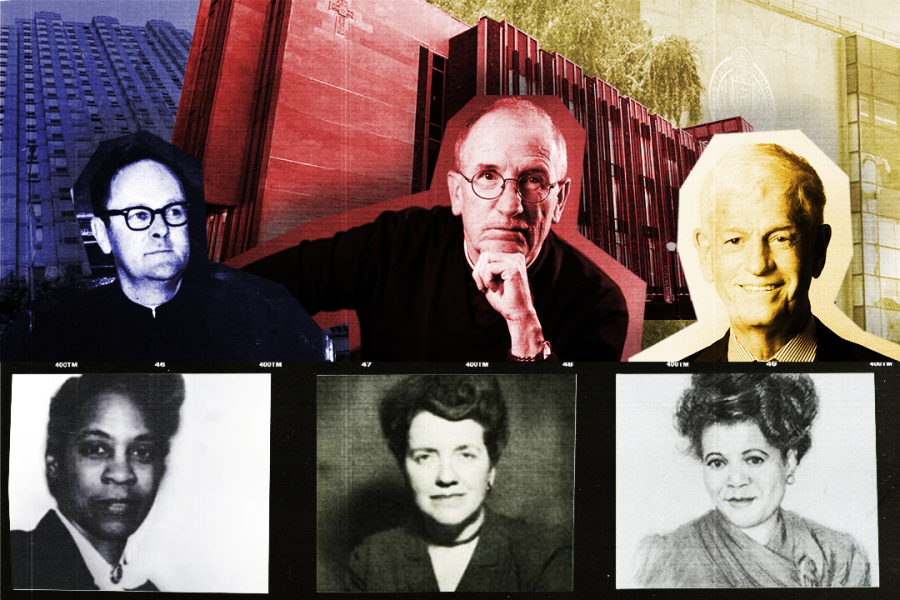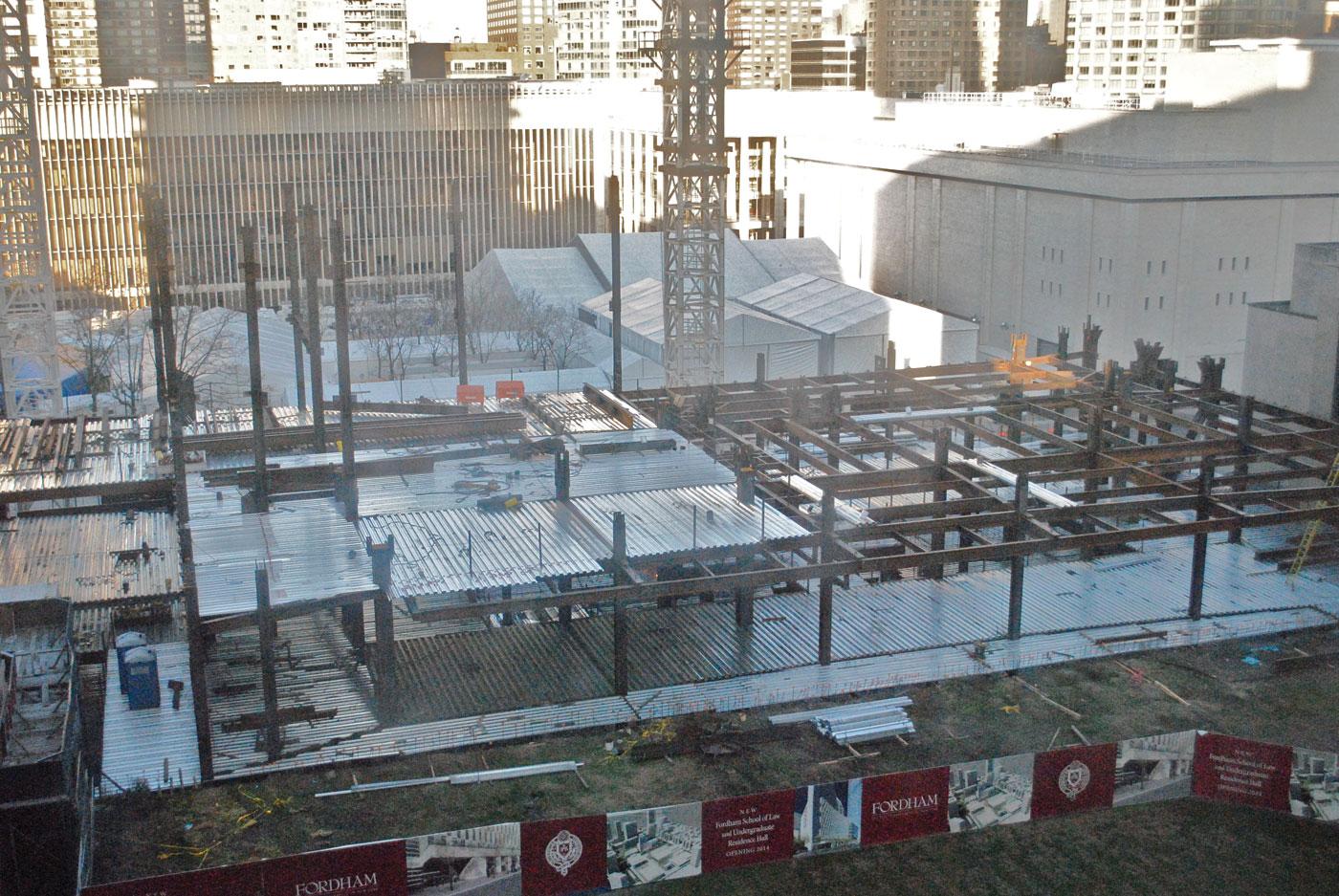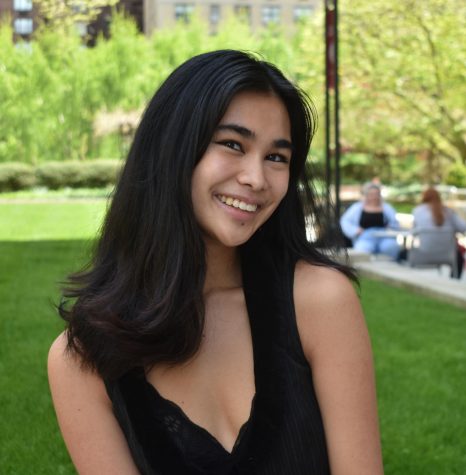The Woman, the Building
Fordham must incorporate more women when naming its buildings
Notable men of Fordham (from top left: George G. McMahon, S.J., Joseph M. McShane, S.J., and Mario Gabelli) have buildings named for them, while notable women (from bottom left: Marie Clark Taylor, Anne E. King, and Ruth Whitehead Whaley) do not.
September 14, 2022
In many ways, Fordham has opened its doors to be more inclusive to women of academia. Previously an all-male institution, the school now enrolls more women than men, and women have almost equal representation with men in the faculty. And our university’s president is, at last, a woman.
Unfortunately, such contemporary changes cannot undo historical injustices. Just because Fordham is making progress today doesn’t mean that its long history as a predominantly-male institution isn’t still notable. The school remains disproportionately focused on men in terms of the names of our campuses’ buildings, almost none of which bears the name of a woman. It’s time for that to change.
In my review of all Fordham buildings, which I conducted by scanning current maps of the Rose Hill and Lincoln Center campuses and looking up every name appearing on the maps (aided by a revealingly named library guide, “Fordham University History: The Man – The Building”), I found that, by the most liberal estimate, only two buildings (out of 32 total) are named for women: Saint Mary of Queen’s Court and Susan Conley (née Salice) of Salice-Conley Hall, both at Rose Hill. It should be noted, however, that Salice-Conley is named for the families of donors Susan and Tom Conley. A fountain at Rose Hill is named for Carolyn Dursi Cunniffe, Ph.D., an alumna of Fordham, but the actual Cunniffe House is named for her husband Maurice J. Cunniffe.
No building at Lincoln Center is named for a woman. Not one of our academic buildings is named for a woman. None of our athletic fields at Rose Hill is named for a woman.
Of course, it must be said that this isn’t the result of active, hostile sexism: It’s not as though the building-namers of years past looked at a list of potential names, stroked their mustaches, and scratched out all the female names while chortling to themselves about the inferiority of the “fairer sex.”
Fordham’s buildings are named in this way because of the passive, insidious misogyny that has pervaded our culture for centuries.
The buildings are (for the most part) named after Jesuit saints and people who have been important to the history of Fordham. These two categories do not allow for many women to be on the list in the first place.
Until then, there are a number of trailblazing women of Fordham’s past who may not have been president of the university but are certainly worthy of having a building named after them.
The school’s preference for Jesuit saints is understandable, but as women cannot enter the Society, all but one of the saints associated with Fordham buildings are male. Even the one seemingly feminist holdout, Queen’s Court, harbors relics of the patriarchy in its wings: Robert’s, John’s, and Bishops’.
And given that Fordham was founded as a seminary, only began to accept women to its undergraduate classes in 1963, and has been run by priests until 2022, it is not surprising that men were always at the top of administrators’ minds when they dedicated new buildings.
But it doesn’t have to be this way. For one thing, we now have a female president — and I look forward to the possible dedication of Tetlow Hall one day. Until then, there are a number of trailblazing women of Fordham’s past who may not have been president of the university but are certainly worthy of having a building named after them.
For example, Anne E. King, who in 1939 became Fordham’s first female dean and served in that role for 25 years. In her time, she was also president of the American Association of Schools of Social Service and helped found Fordham’s first master’s degree program.
Marie Clark Taylor, a Black woman who received her Ph.D. in botany from Fordham in 1941, was the first woman to receive a Ph.D. from the university and the first African American woman ever to receive a Ph.D. in botany.
Ruth Whitehead Whaley was the first Black woman to be admitted to Fordham’s Law School, enrolling in 1921. She graduated in 1924, becoming one of the first Black women to practice law in the state of New York and the first Black woman to do so in her home state of North Carolina.
Finally, some recognition should go to Fordham’s first female undergraduates, who were initially admitted to a separate college named after St. Thomas More (because even the women’s school had to be named for a man). In the 10 years of Thomas More’s existence, the new “coeds” (as they were called) had to deal with hostility from male students and restrictive policies, such as no mixed-gender classes, from the administration. There are many women among Fordham’s first who might be considered for recognition.
There are many female saints worthy of honor, and we don’t even have to stray far from Fordham’s existing buildings to find some.
Among them is the brilliant Sue Kahl. She may never get a building, but I will hold out hope for at least a plaque. In Kahl’s time, some of her male peers childishly insisted that the new women weren’t worthy of courting. When asked by The Fordham Ram about this in 1965, Kahl responded that the men didn’t have to worry about that: “Fordham guys are not exactly prize packages.”
As for saints, we don’t have to wait for the Jesuits to start admitting women to their ranks. There are many female saints worthy of honor, and we don’t even have to stray far from Fordham’s existing buildings to find some. For example, Fordham currently honors three male Jesuit missionaries who came to New York to evangelize to the Native American population: Sts. Goupil, la Lande and Jogues, of Martyrs’ Court. But no recognition is given to the people to whom they were missioned.
An easy (and long overdue) way to address that is to honor St. Kateri Tekakwitha. Kateri was a Mohawk woman in the late 17th century who converted to Christianity at the age of 19. Her conversion is due to the presence of Jesuit missionaries (successors of Jogues and the martyrs), but her deep devotion can only be attributed to her. In 2012, she was the first Native American to be canonized. She would make an excellent addition to the list of saints Fordham honors in the names of our buildings.
Every year Fordham puts off honoring women in the same way it honors men is another year the school neglects the debts it owes to Fordham women.
Of course, Fordham doesn’t get a new building every day, so this proposal necessarily involves removing some existing male names from certain buildings. Such changes might certainly cause frustration, but we should remember that Fordham changes its buildings’ names quite frequently. Earlier this year, on April 27, the McGinley Center became the McShane Center.
Furthermore, changing the name of a building does not have to mean erasing the legacy of its original namesake. We can preserve the memory of the important people of Fordham’s past in scholarships, statues, works of art, dedication of classrooms and wings of buildings, to name a few.
The concern of what to do with the existing names of buildings, however, is secondary to the issue of recognizing women. Every year Fordham puts off honoring women in the same way it honors men is another year the school neglects the debts it owes to Fordham women.
It makes sense for Fordham to honor the great men who led the school to its current position, and it makes sense to honor the history of the Jesuits. But the history of Fordham is not limited to men, and the history of the Jesuits is not limited to Jesuits themselves. Our buildings can honor our entire history, the parts we’ve always been proud of and the parts whose importance we only recently came to acknowledge.













Ed Holabird FCLC '97 • Sep 23, 2022 at 2:40 pm
“140 West” would be a slam dunk of a rename.